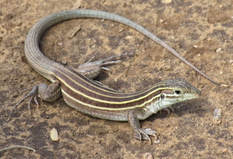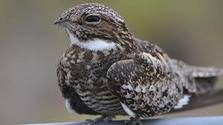 Sara Wright Every morning when I go out to water my potted plants and the remnants of the chamisa bushes that were sacrificed during the process of building I meet the lizards. I have two kinds - sagebrush lizards and the desert grassland whiptails. Both of these reptiles appear to enjoy my company as much as I enjoy theirs, or perhaps they are just waiting for the water to start flowing. This morning when I planted a few coyote gourd seeds in a hole that I had recently dug a whiptail lizard emerged like magic from somewhere under the house delicately positioning himself at the edge of the water logged hole for a drink. In the early morning light his stripes shimmered in the sun. The annoying thing is that I never have a camera with me to capture these morning antics, but I look forward with anticipation to seeing these lizards scurrying about every day. Desert grassland whiptails are very long and slim, with a thin tail that is longer than their body length. The most distinct identifying feature of these lizards are the six yellow lines – some very bright - that run the length of their bodies. The rest of the whiptails bodies, around here at least, tend to be olive or brown. Their tails are faded blue or gray. Curiously, an adolescent's tail is a very bright and vibrant blue so I am always on the look out for the young ones. Whiptail bodies are lined with small coarse scales, which gradually get larger towards their tails. The scales on their bellies are larger and smoother. Desert grassland whiptails are found in the deserts of southern to central Arizona and along the Rio Grande River in New Mexico. They are also found in the deserts of northern Mexico. A. uniparens is commonly found in low valleys, grasslands, and slight slopes. Some have argued that the species' range is expanding due to overgrazing. They are scarce in developed areas, especially where homeowners keep livestock. One amazing fact is that all desert grassland whiptail lizards are female! Strangely, researchers note that a kind of pseudo-copulation occurs which promotes fertilization during ovulation. The lizards reproduce by parthenogenesis, but offspring do not necessarily have the same chromosomes as their mother. This is because the lizards start off with twice the amount of chromosomes as would be found in sexually reproducing individuals. Diversity is maintained by combining sister chromatids which have the same origin but different functions. Whiptails eat spiders, termites, ants of all kinds, beetles, and short-horned grasshoppers. These food habits make them very appealing to gardeners like me who don’t use any toxic chemicals to prevent insect infestations. Whiptails are constantly in motion! They often run upright on their hind legs, giving them the appearance of miniature dinosaurs! They also swivel their heads frequently from side to side, taste the air with slender forked tongues, and use their pointed snouts to probe the ground as they forage. Their speed, and agility help them outmaneuver predators such as thrashers, roadrunners and snakes. One of my Chihuahuas, Lucy, is fascinated by them and always tries to chase them into the cottonwood leaves! Did you know that these lizards can sprint up to fifteen miles per hour (as fast as a roadrunner)? Whiptail lizards can also escape capture by sacrificing their tails (when grasped, their tail breaks easily along a fracture plane in the vertebrae). The disembodied tail wriggles violently, which startles and distracts the predator while the lizard dashes to safety. Whiptails are wily creatures, beautiful to look at, and fun to watch. They do seem to enjoy scurrying around my feet as I water. I always talk to them, and when I do they watch me and listen with apparent curiosity. In my opinion, paying close attention to these little characters will bring joy into your day!
0 Comments
 Night Song Sara Wright For the last three nights I have been awakened by a bird singing at around 3AM. The first and second nights I heard three short cheeps and a strange buzzing call. These calls were repeated a number of times. Last night the bird that heard made three soft calls a number of times. No buzzing. Mystified by the night song occurring just outside my window I finally did a bit of research on the sounds of birds made by the nightjar family because although these calls were different, I am familiar with the species in general – especially the whippoorwill. After listening to bird recordings I was sure the buzzing sound was part of the mating dance of the male whose wings made the sound. The common nighthawk (Chordeiles minor) is a medium-sized crepuscular/nocturnal bird, part of the nightjar family. Typically dark grey, black and brown, these birds display cryptic coloration and are intricately patterned. This bird is almost impossible to spot during the day. On a moonlit night the nightjars that I have seen fly erratically. The most remarkable feature of this insectivore is its small beak that seems a bit at odds with its full rounded and somewhat squat body. The common nighthawk does not travel frequently on the ground, instead preferring to perch horizontally, parallel to branches, on posts, on the ground or on a roof. It has very short legs! There is apparently some variability in territorial size. I have never seen more than one pair in an area at once. The most conspicuous vocalization is the nasal high pitched call most frequently heard during crepuscular flight. Peak vocalizations are reported 30 to 45 minutes after sunset according to most sources. No source mentioned 3 AM calls! In defense of their nests, the females make a rasping sound, and males clap their wings together. Males will also perform dives against fledglings, females and intruders such as humans or raccoons. Frequent flyers, the long-winged common nighthawk hunts on the wing for extended periods at high altitudes or in open areas. Flying insects are its preferred food source. The hunt ends shortly after dusk turns to night, and resumes before dawn. Needless to say I have been on alert hoping to see a nighthawk in flight. For me the easiest way to identify them is by their size – they are medium sized birds (about 8 inches in length) and their v shaped wings. Vision is presumed to be the main detection sense. The average flight speed of common nighthawks is about 15 miles an hour. The nighthawk breeds during the period of mid-March to early October. It most commonly has only one clutch per season. The bird is assumed to breed every year and is monogamous. Courting and mate selection occur partially in flight. The male dives and booms in an effort to garner female attention; the female may be in flight herself or stationary on the ground. The three calls I heard were located just outside my window. Females choose the nest site and are the primary incubators of two eggs for about 18 days. The female will leave the nest unattended during the evening in order to feed. The male will roost in a neighboring tree; he guards the nest by diving, hissing, wing-beating or booming at the site, and feeds his mate while she sits on the eggs. Later he helps feed his chicks. In the face of predation, common nighthawks do not abandon the nest easily; instead they likely rely on their cryptic coloration to camouflage themselves. In a month the fledglings will be independent. Because of their nesting habits these birds are easy prey for raccoons who covet their eggs. Dogs, coyotes, owls and foxes are other predators. During migration, common nighthawks may travel 2,500 – 4500 thousand miles, migrating by day or night in loose flocks (that could number in the thousands) between breeding grounds throughout the US and the birds’ wintering range in South America. Their populations are in decline for the usual reasons – loss of habitat, pesticides etc. During warm summer nights I watch them fly by my porch after insects, and have never tired of the sight. |
Submit your ideas for local feature articles
Profiles Gardening Recipes Observations Birding Essays Hiking AuthorsYou! Archives
October 2025
Categories
All
|
 RSS Feed
RSS Feed